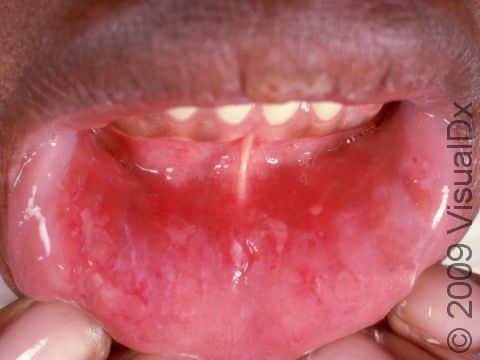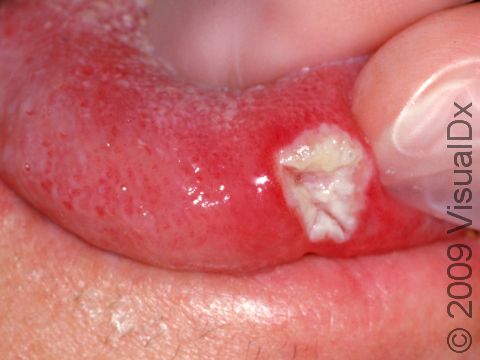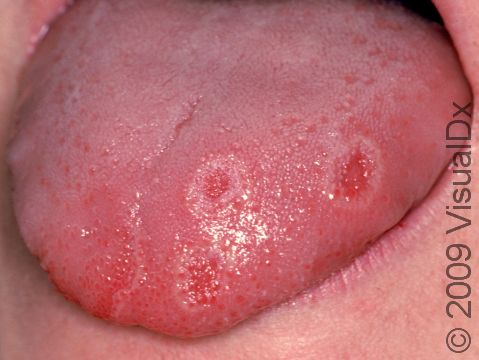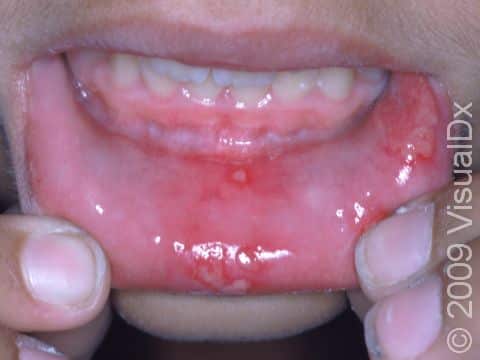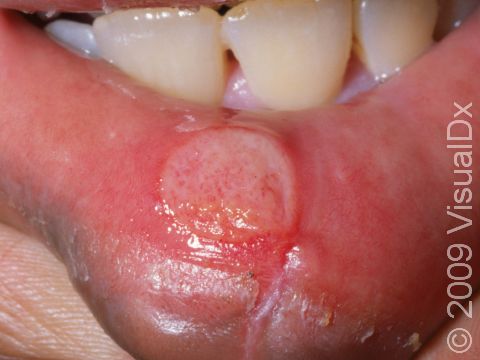Canker Sore (Aphthous Ulcer)
Aphthous ulcers are also called canker sores; these are a very common kind of mouth sore that affect many people. In general, canker sores are shallow, tender sores that are whitish or yellowish in the middle and red around the edges. They tend to occur on the inner lips or cheeks, the gums, and the top of the mouth. There are different methods of classifying the ulcers based on their size; most people develop minor ulcers, which are quite small, and some people develop major ulcers, which are big (up to a centimeter in diameter.) No one is sure what causes canker sores, but some people are more prone to them. There are likely many factors that do cause them, such as different viruses, being stressed, lack of sleep, having poor nutrition, or small injuries to the mouth caused by biting, toothpastes, or foods. There is no cure for canker sores, but sometimes a topical steroid cream or numbing cream can make them feel better. Because no one is sure what causes them, it is hard to know how contagious they are, but it is probably best to avoid intimate contact, such as kissing, while the canker sores are open and painful.
Who's At Risk?
Anyone can get canker sores, though it seems that, even among healthy populations, some people are more prone to them. There may also be a tendency to get canker sores that runs in families. The most common age groups are older children, teens, and adults. Anyone with a weakened immune system will be more likely to develop mouth ulcers.
Signs & Symptoms
Minor aphthae are single or multiple lesions, 1.0 cm or less in diameter.
Major aphthae are deep ulcers greater than 2.0 cm in diameter.
Herpetiform aphthae appear as multiple ulcerations.
The most common locations of canker sores are inside the mouth or lips or on the tongue. The genitals may also be affected. The sores can have a white, gray, or yellow base.
Self-Care Guidelines
There is no cure for canker sores. Most heal in 1–2 weeks, but the following measures may help relieve the pain:
- Apply protective pastes to form a barrier over the sore.
- Apply local anesthetics (benzocaine, lidocaine) to help numb the area.
- Use antibacterial mouthwashes.
- Avoid products or foods that seem to trigger canker sores.
- Maintain a good diet or take vitamins.
- Get enough sleep and reduce stress.
Treatments
Most people are treated with topical steroids or other medications applied to the affected area, to speed up healing of the lesions. These include:
- Topical calcineurin inhibitors (tacrolimus or pimecrolimus)
- Prednisone may be used in severe cases
Other oral medications, dapsone and colchicine, may be used in more severe cases, when repeated outbreaks (recurrences) continue for years.
Visit Urgency
See your doctor if canker sores do not heal, occur frequently, or if you have extreme discomfort or pain.
References
Bolognia, Jean L., ed. Dermatology, pp.419, 1087. New York: Mosby, 2003.
Freedberg, Irwin M., ed. Fitzpatrick’s Dermatology in General Medicine. 6th ed. pp.1115-1116, 1098-1099, 2360, 2467. New York: McGraw-Hill, 2003.
Last modified on August 16th, 2022 at 2:44 pm

Not sure what to look for?
Try our new Rash and Skin Condition Finder
